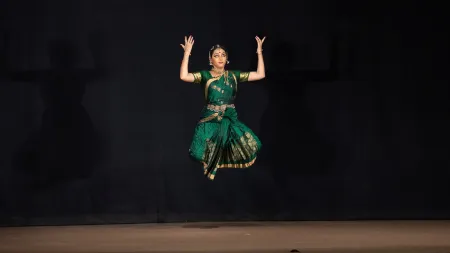- India
- International
‘Textile remains the most visible aspect of our living heritage’: Exhibition spotlights neglected history of heirloom clothing
"Textile conservation involves the technical, scientific and historic documentation of textiles, with primary focus on their storage and display to preserve their essence and cultural significance," said Smita Singh, independent textile conservation consultant
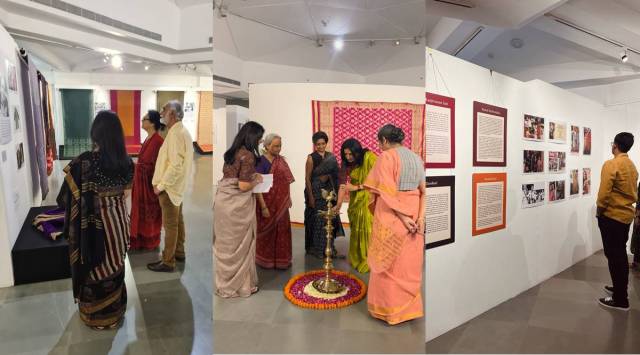 Aina exhibition takes place at IIC, Delhi from 13 to 21 May (Pic source: Saarekah Agarwaal)
Aina exhibition takes place at IIC, Delhi from 13 to 21 May (Pic source: Saarekah Agarwaal)“A beautiful textile may last a lifetime, but a textile with memories may last forever,” said Saarekah Agarwaal, textile archivist, researcher, and curator of the recently inaugurated textile exhibition — Aina. Comprising around 20 participants, who have loaned their treasured family heirlooms for display, the unique show highlights the history of the garment along with the emotional value and memory attached to it. As such, while looking at the displays, one not only marvels at the spectacular craftsmanship of the brocade saris from Varanasi; Korvai’s Kanchipuram saris; exquisite Kachchh embroidery; and zardozi work, among other Indian textile art forms, but also gets to read about their rich history — when the owner bought or inherited it, what value it holds in their life, how they used it over the years, and what that the piece of cloth reminds them of, among other things.
Talking about her zardozi-embroidered striking gold kimkhab lehenga, Veena Gupta, a participant, said that the nicely preserved garment originally belonged to her mother — who wore it for her wedding — and was passed down to Gupta, who also wore it to her wedding in 1974, and now will be passed it down to her future daughter-in-law.
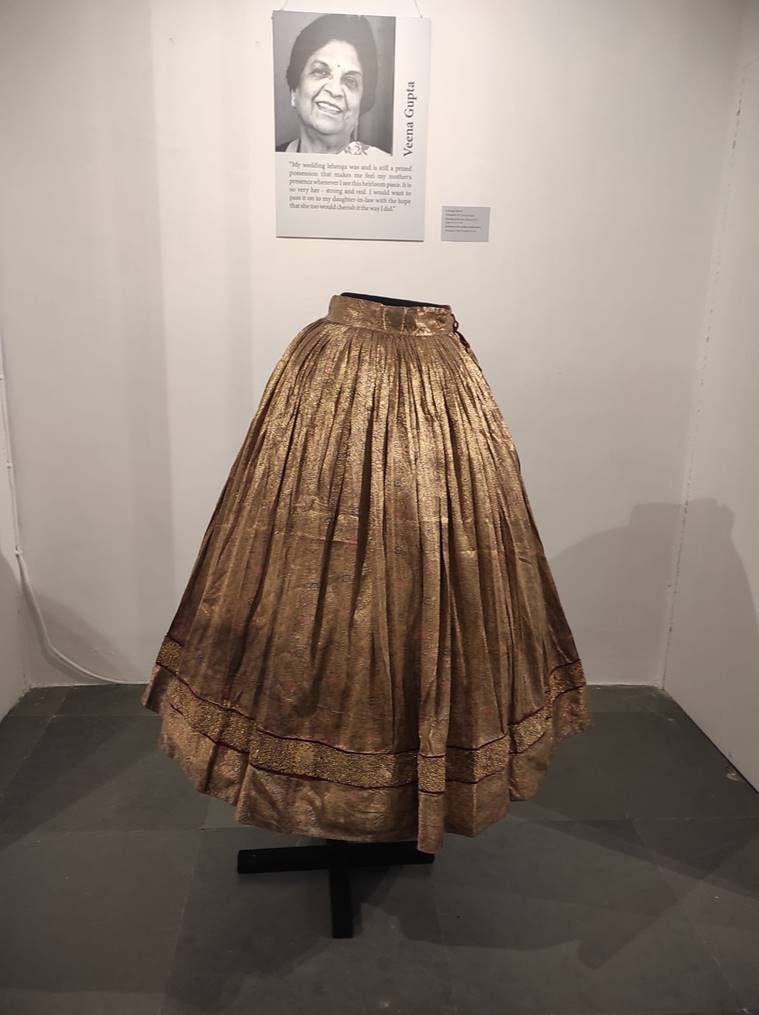 Veena Gupta’s striking gold kimkhab lehenga embroidered with zardozi on display at IIC. (Photo: Tahira Noor Khan)
Veena Gupta’s striking gold kimkhab lehenga embroidered with zardozi on display at IIC. (Photo: Tahira Noor Khan)
Similarly, Shobha Bhandari’s more than a century-old purple velvet jacket with zardozi work is not just an old garment, but one that is infused with memories and emotions. “Brought by my grandfather, my father first wore this coat in 1894 — when he was nine years old. It is a family jewel because it’s not only a rare piece to find but every bit of it seems to contain the very essence of my father, whom I lost years ago. It’s a symbol of our family’s identity. Unfortunately, looking at its condition today, I only hope that there is some museum that comes forward to help us preserve it,” her note read.
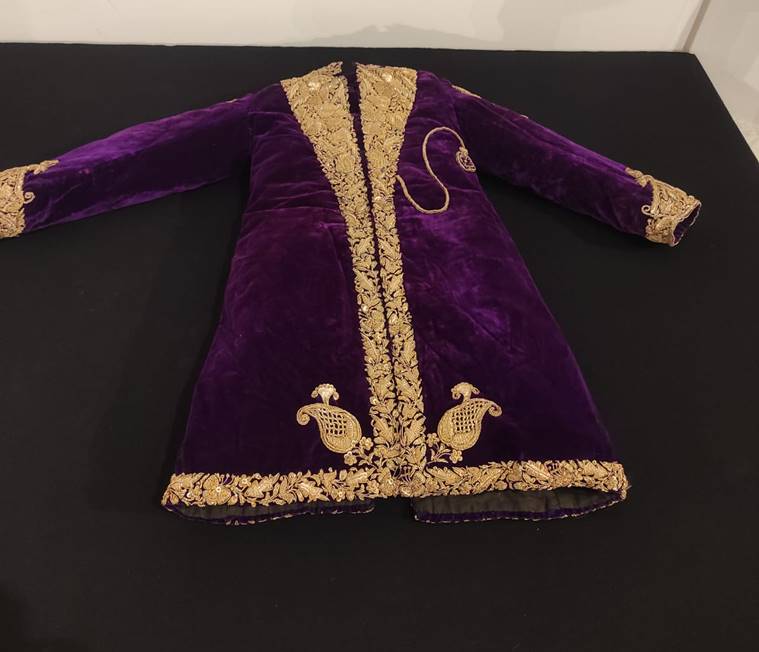 Shobha Bhandari’s more than century-old purple velvet jacket with intricate zardozi work. (Photo: Tahira Noor Khan)
Shobha Bhandari’s more than century-old purple velvet jacket with intricate zardozi work. (Photo: Tahira Noor Khan)
But how does unfolding layers of stories from textiles help in preservation?
“Textile remains the most visible aspect of our living heritage, worn in various ways, each having individualised values in all their diversity. And yet, paradoxically, there is invisibility, deafening silence in its documentation and provenance, and what research can unlock about the many treasures that lie locked up in cupboards and trunks across the country,” said Dr Ritu Sethi, Founder-Trustee, of Craft Revival Trust and Editor, Global InCH, who moderated a talk on ‘Does unfolding layers of stories from textiles help in their preservation?’ on the second day of the exhibition.
Dr Sethi added, “The funny question that arises from this is that by not researching these textiles, we are undermining and negating the value of these treasures and their contribution to textile learning. This exhibition and seminar is a pioneering effort as it attempts to fill this gap”.

As part of her talk, she also highlighted the importance of documentation of heirlooms of common people and ordinary collectors “who may not have a huge collection in terms of depth and width and numbers, but make up for it in stories, in associations, making of inter and cross-generational sharing, and other aspects” — saying that all add to the much-needed gathering of information and scholarship on textiles.
“The importance of the seminar also lies in giving value and validating home collections or recognition to those who own these pieces that their textiles are also a vital part of textile history,” she said, adding that for preserving the histories of common people, there is a need for increased awareness on converting oral histories to the written. “And, in the case of textiles, that acts as part of material history. It is important to preserve the piece of clothing as well as document the stories, stating provenances to dating to remembering names and places or makers. This practice can help preserve not just the piece of cloth but also stories, emotions, art, craftsmanship and history behind it,” she added.
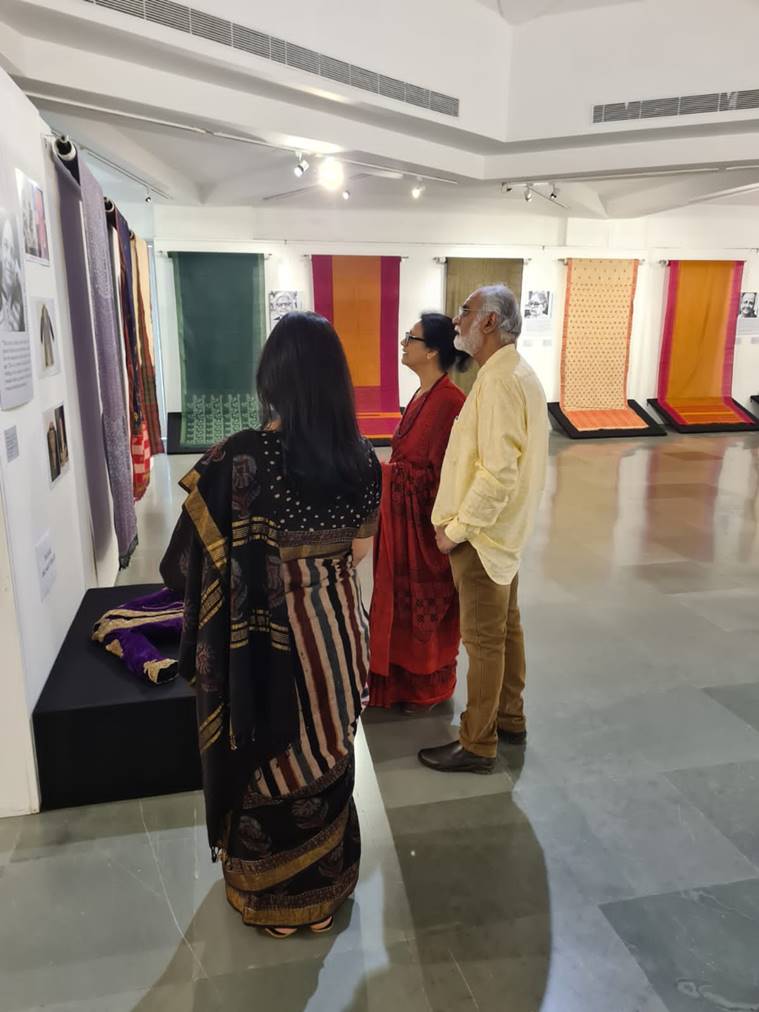 People attending Aina exhibition at IIC, Delhi. (Pic source: Saarekah Agarwaal)
People attending Aina exhibition at IIC, Delhi. (Pic source: Saarekah Agarwaal)
Why is it important to preserve objects of material history?
Talking about the importance of conservation, Dr Achal Pandya, Head of Conservation Unit, Indira Gandhi National Centre for the Arts, said these objects are markers of our memory, and the tangibility of material objects helps us in keeping our memory alive. Similarly, Anamika Pathak, former curator at the Decorative Art and Textiles Department of National Museum, New Delhi said that we are emotional creatures and associate meanings to objects, hence preserving them not only preserve the “object” but also the “associations and stories behind it”.
Agarwaal agreed and said, “Human beings are story-shaped creatures, we are born into stories, raised in stories, and live and die in stories. It is a gift to the next generation and beyond. Stories embedded in textiles are more than a connection between past and present. Their importance is greater than the facts of their beauty and construction”.
But textile conservation is not a new phenomenon
Your mother and grandmother putting winter clothes under sunlight before using them or carefully wrapping up their treasured clothing items inside a soft muslin cloth before storing them in a trunk or a cupboard also amount to textile preservation. In academic terms, “textile conservation involves the technical, scientific and historic documentation of textiles, with a primary focus on their storage and display to preserve their essence and cultural significance. It is part of the broader field of art conservation which aims to safeguard tangible cultural heritage for future generations,” explained Smita Singh, an independent textile conservation consultant.
However, we do not need to be a conservationist to preserve our treasured pieces of clothing. Giving an example of how textile conservation is not a new concept and how it has been in practice, Singh shared an anecdote from one of her conservation projects – City Palace, Udaipur. “There is a similarity in techniques used by custodians in India to preserve their textiles using traditional methods and those used by modern conservators,” she said.
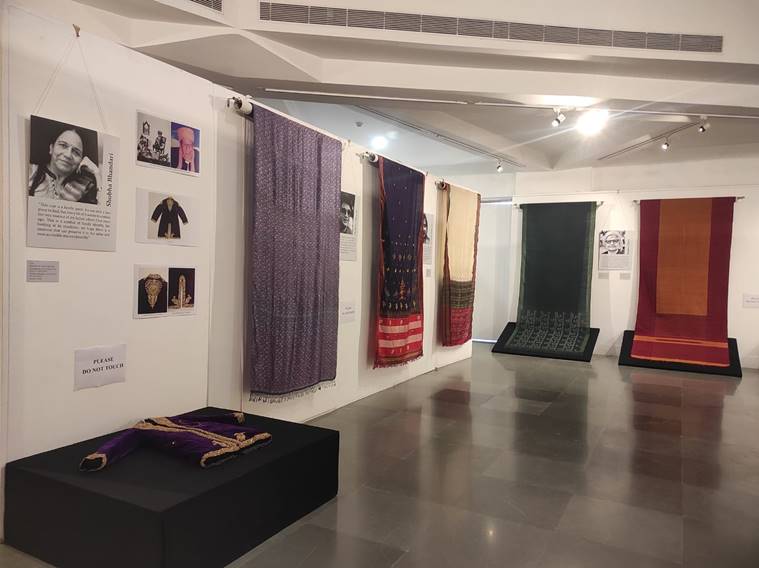 Textile on display at Aina exhibition at IIC, Delhi (Photo by Tahira Noor Khan)
Textile on display at Aina exhibition at IIC, Delhi (Photo by Tahira Noor Khan)
She elaborated, “There is a similarity in techniques used by custodians in India to preserve their textiles using traditional methods and those used by modern conservators. At the City Palace Udaipur, we were working for conservation and when we started opening clothing boxes that were closed in the 1940s under the supervision of Rajmata Sahiba Sushila Kumariji – we were amazed at how meticulously everything was done”.
Registers were prepared by Rajmata that had information of which piece of clothing belonged to whom, who wore what textiles in which festival, among other things. The boxes in which clothes were kept were properly numbered. The clothes were packed in trunks wrapped in muslin cloth and to preserve them from insects and pesticides, properly rolled tobacco leaves were kept in a separate section of each trunk, she elaborated.
“I was amazed to find these clothes that were packed in the 1940s and opened by me in 2014 were still meticulously intact – the silk clothes, the woollen clothes – everything.”
Agreeing with Singh, Namrata Dalela, a Conservation Consultant who has worked on the Lost and Found exhibition with the Indian diaspora in the USA said, the first step towards conservation starts by realising the values of objects around us. “People have so many family heirlooms around them whose value they themselves do not realise. It is important to understand their significance in the first place, in order to preserve them”.
The show is on display until May 21 at Kamaladevi Complex, India International Centre.
📣 For more lifestyle news, follow us on Instagram | Twitter | Facebook and don’t miss out on the latest updates!
Apr 18: Latest News
- 01
- 02
- 03
- 04
- 05

























